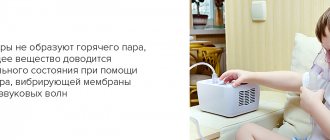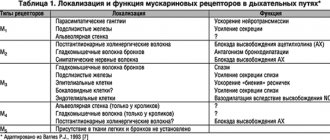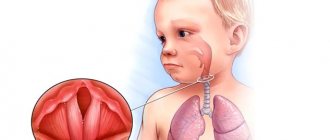Use of inhalations
- For the prevention of respiratory diseases and moisturizing the mucous membrane of the respiratory tract.
- Treatment of bronchial asthma, chronic bronchitis, cystic fibrosis, COPD.
- In the complex treatment of rhinitis, sinusitis, pharyngitis, tracheitis, bronchitis.
- For children and the elderly.
- For patients with severe illnesses.
Causes and treatment of cough
Benefits of inhalation
- Direct delivery of the drug to the area of inflammation.
- Pure substance without impurities.
- Possibility to introduce any amount of dosed substance.
- Fast, instant action of the drug.
- Fewer side effects, since the drug does not enter the blood.
- Permitted for use in infancy, in postoperative conditions, and in coma.
- Maximum efficiency at the lowest cost.
Contraindications
Inhalations are not recommended for:
- elevated body temperature;
- cardiovascular failure;
- nosebleeds;
- emphysema;
- oncological diseases.
Contraindications are:
- Spontaneous pneumothorax
- Common and bullous forms of emphysema
- Bronchial asthma with frequent attacks
- Pulmonary heart failure stage III
- Pulmonary hemorrhage
- Arterial hypertension III degree
- Severe atherosclerosis of coronary and cerebral vessels
- Inner ear diseases, tubotitis, vestibular disorders
- Atrophic rhinitis
- Epilepsy
- Individual intolerance to the drug
Types of inhalers
The inhalation therapy method is based on the penetration of medicinal substances into the respiratory tract in the form of an aerosol, that is, tiny particles suspended in a gaseous medium. If aerosol is inhaled:
- particles larger than 5 microns settle in the oral cavity and upper respiratory tract;
- particles from 1 to 5 microns settle in the lower respiratory tract;
- particles with a diameter less than 1 micron are exhaled back.
Inhalers are divided into types depending on the mechanism of particle formation.
Ultrasonic nebulizers
In ultrasonic inhalers, the drug is atomized due to high-frequency vibration of piezoelectric crystals.
Research shows that ultrasonic inhalations are effective due to the spraying of not only the medicinal substance itself, but also negatively charged particles, which have an additional anti-inflammatory effect.
However, this type of inhaler has a drawback: exposure to ultrasound destroys many medications (for example, antibiotics and phlegm thinners).
Compressor inhalers
A compressor inhaler converts the drug into a fine aerosol using compressed air from a compressor.
The compressor inhaler is considered the most effective for affecting all parts of the respiratory tract. Its great advantage is the creation of an aerosol suspension with a very small particle size of the drug substance. You can use any medications that are intended for inhalation.
Steam inhalers
Based on the evaporation of medicinal substances under the influence of high temperatures.
Flaws:
- you can get a burn to the mucous membrane;
- affect only the upper respiratory tract;
- at high heating temperatures they reduce the biological activity of medicinal substances.
In medical practice, two types of inhalers are usually used: compressor and ultrasonic.
How to and how not to be treated with a nebulizer
What is a nebulizer?
This is a device that appeared on the market relatively recently; it serves to cleanse the lungs and treat various diseases associated with the respiratory system.
Creates a fine aerosol from a liquid (very small droplets suspended in the air). The person then inhales it through a tube or mask. What does the name "nebulizer" mean?
The term "nebulizer" comes from the Latin word nebula - fog, cloud.
Does a “healthy” person need a nebulizer?
In many cases - yes! After all, it helps cleanse the respiratory system.
Many seemingly healthy residents of cities and towns are forced to “cleanse themselves” for three or four minutes every morning—clear their throats in the bathroom or—excuse me—blow their nose. And all this is precisely because, figuratively speaking, our airways are clogged due to poor ecology. Moreover, this should be done not only by those who lead a sedentary lifestyle. People who lead a healthy lifestyle sometimes suffer from poor ecology and air pollution even more than those who are not used to bothering themselves with physical exercise! After all, when jogging, cycling, skiing, and in general during any active sports in the city or near the city - in “sort of fresh air” - we push gigantic volumes of not very clean air through our lungs. So, on the one hand, rapid “sports” breathing is beneficial for the lungs and heart - and on the other hand, with such breathing, we, figuratively speaking, more actively “pump” harmful substances into the lungs. Learn more about how to cleanse your lungs, including using a nebulizer.
In addition, even the healthiest person sometimes gets respiratory tract infections. Doctors have repeatedly suggested that you take antibiotics to fight a bacterial infection. In tablets or injections. As you understand, almost all antibiotics have a systemic effect on the body and cause side effects. And the higher the dose of antibiotic, the more serious the various adverse reactions. So, if you supply antibiotics through a nebulizer, then it will flow directly to its destination - into the bronchi and lungs. This means that a smaller dose of antibiotic will be required, and the side effects for the whole body will also be less. By the way, antibiotics through a nebulizer can be used not only for bronchitis and pneumonia, but also for tracheitis, otitis media, sinusitis and sinusitis. It is especially good to use this therapy for treating children, because the procedure is absolutely safe and painless, and the 5–10 that it takes, let the child watch cartoons, this is much better than nasty pills or unpleasant injections.
What medications and for what diseases can be used with a nebulizer?
Nebulizer therapy uses:
- drugs for thinning sputum and improving expectoration (acute and chronic bronchitis; pneumonia; COPD; bronchial asthma with difficulty in sputum discharge) - Ambrohexal, Ambroxol, Lazolvan, Ambrobene, Fluimucil, Acetylcysteine
- drugs that dilate the bronchi, relieve bronchospasm (COPD; bronchitis, including obstructive; bronchial asthma (endogenous, allergic); some types of pneumonia; laryngitis.) - Berodual, Ventolin, Berotek, Salbutamol, Salamol
- hormonal drugs with multifaceted effects, primarily anti-inflammatory and anti-edematous (bronchial asthma requiring maintenance therapy with corticosteroids; COPD) - Budesonit, Pulmicort, Budenit
- antiallergic drugs (hay fever, allergic rhinitis, including seasonal and/or year-round) - Cromohexal
- antibiotics for the destruction of bacteria that cause diseases and associated infections (bronchitis, tracheitis, pneumonia, catarrhal and purulent otitis, sinusitis, sinusitis) - antibiotic prescribed by a doctor + Fluimucil
- slightly alkaline and saline solutions to moisturize the mucous membranes in order to speed up the process of mucus removal: saline solution, soda-buffer solution.
We remind you that all medications, especially antibiotics, hormonal and systemic drugs, can only be used as prescribed by a doctor . Their administration using a nebulizer should also be discussed with your doctor . By the way, if you are planning to purchase or already have a nebulizer, inform your doctor about this. Although for many doctors, of course, it is easier to prescribe you pills, injections or droppers than to select nebulizer therapy, since this requires additional effort and higher qualifications.
What else do you need to know about nebulizers?
Be sure to carefully read the instructions for the device and the medicine, and strictly follow the doctor’s instructions. It should be taken into account that some medications should be diluted in saline, some in distilled water, and some should not be diluted. It is important to remember that solutions that can be used with a nebulizer are usually labeled “for inhalation”, and there is also a special ready-made form of such solutions - “nebula” packaging.
Some medications cannot be used in ultrasonic nebulizers.
You should also know that when simultaneously prescribing several types of drugs for nebulizer inhalation, it is necessary to adhere to a certain sequence of administration of the drugs. Bronchodilators should be inhaled first, followed by mucolytics. And after this, anti-inflammatory and antiseptic agents can be administered.
The medicine must be at room temperature!
To minimize the risk of side effects, rinse your mouth thoroughly with water after each inhalation of medications.
Try to keep the aerosol cloud out of your eyes.
To prevent skin irritation, your face should be washed after using the nebulizer with a mask.
How not to be treated with a nebulizer?
Please do not experiment with medications!
There is a widespread false claim on the Internet about the usefulness of using herbal decoctions and tinctures during nebulizer therapy (for example, for the prevention of acute respiratory infections). The use of essential oils, decoctions and infusions of medicinal herbs in nebulizers is unacceptable without a direct prescription from a doctor! The fact is that such liquids contain microscopic particles of plants, tannins, polysaccharides and other components, so if they get into the lungs and bronchi, acute allergic reactions, pulmonary spasms, bronchospasm, severe coughing and other troubles are possible. Essential oils can also cause damage to both the device and your lungs. It is better to use such products as part of aromatherapy (evaporate on a cushion of water through aroma lamps), or inhale through ordinary glass or steam inhalers, following the instructions for use.
If we talk about the real dangers that can result from improper use of a nebulizer, then you must remember to disinfect the nebulizer, hoses, and masks before the first and after each repeated use. Imagine what you will breathe through a nebulizer if mold grows in the unwashed and undried nebulizer or the remains of the medicine disintegrate into unknown components. Therefore, what is possible according to the instructions - we boil, what is not - we wash and disinfect, for example, with chlorhexidine, then dry it. It is best for each family member to use their own set of accessories (mask, mouthpiece), since they are inexpensive. We must not forget about timely change of filters; most often they are included with the device.
And be sure to consult your doctor about possible contraindications: these may include pregnancy, some pulmonary diseases, etc.
Do not pour any herbal decoctions, tinctures, solutions containing suspended particles, oils, mineral water, etc. into the nebulizer container! Only medicine or saline solution approved by your doctor! Otherwise, you can damage the device and harm your health!
Can mineral water be used in nebulizers?
The use of mineral water in nebulizers causes a lot of controversy. The opinions of medical specialists are diametrically opposed.
The Internet is full of implausible and carbon-copy “horror stories” on this topic. Moreover, the persistence with which such strange stories are spread on various forums is quite surprising.
At first glance, there is nothing dangerous in mineral water. We swim in the sea, breathe sea air, and sea water is much more saturated with salts than ordinary mineral water. But let’s still agree that until real research on this topic appears, we will refrain from drinking mineral water for inhalation through a nebulizer!
The composition of mineral water is extremely unstable, it is unsterile. Moreover, mineral water is often counterfeited. Therefore, if your doctor still prescribed mineral water for inhalation, you should only buy it at a pharmacy and check that it has a neutral or slightly alkaline reaction.
What advantages does a nebulizer have over traditional inhalers?
use of drugs in minimal effective doses. Reducing the doses of drugs entering the body is especially important for potent and hormonal drugs; a smaller dose means fewer side effects. continuous supply of small doses of medication during the session, in contrast to a single, but loading dose in inhaler sprays, is much more effective. allows, in contrast to metered-dose aerosol inhalers, to administer pure medications to all respiratory organs (nose, bronchi, lungs), without any impurities (solvents or carrier gases), which also reduces the load on the lungs and reduces the likelihood of side effects. can be used at any age, since the patient is not required to perform any conscious actions, for example, pressing the inhaler canister while inhaling, which is especially important in young children. there is no need to take a strong breath - it is important in cases of a severe attack of bronchial asthma, as well as in bedridden patients, patients in childhood, the elderly or with developmental disabilities.
Who simply needs a nebulizer to significantly improve the quality of treatment, and in many cases, the quality of life?
- patients with chronic or often recurrent bronchopulmonary diseases (bronchial asthma, COPD, chronic bronchitis, cystic fibrosis), for the complex treatment of cough with difficult to separate sputum.
- families with a child who is susceptible to frequent colds and bronchitis
- people with occupational diseases of a bronchopulmonary nature.
To whom do we highly recommend nebulizer prevention of respiratory diseases?
- smokers, including former
- athletes
- those who need to talk often and a lot (teachers, lecturers, telephone operators) or have contact with people (at work, in transport, in public places)
- elderly people
- residents of large/industrial cities
- for lovers of healthy lifestyle, spa, cleansing procedures
Can a nebulizer be used to treat children?
If prescribed by a doctor, nebulizers can be used to treat children from a very early age. Moreover, many manufacturers have special children's models made in the form of toys (B.Well PRO-115). “Children’s” models of nebulizers are equipped with special children’s and infant masks, they are less noisy, and they have inhalation speed control (B.Well MED-125).
Can a runny nose be treated with a nebulizer?
It’s possible, some nebulizer models are even equipped with special nasal attachments (for example, B.Well PRO-110).
An important condition is that nebulizer therapy is suitable for treating runny nose only of a non-infectious nature.
Exclusive information: inhalations with saline help in the treatment of atrophic rhinitis (in approximately 70% of cases).
What is the nebulizer fraction?
A very important characteristic of any nebulizer is the indicators of the nebulizer (respirable) fraction. Despite the fact that outwardly it seems that steam is coming out of the nebulizer, you need to understand that this is not steam, but an aerosol consisting of small particles of a sprayed substance. The size of these particles directly affects which part of the respiratory tract they settle in. The smallest particles are able to penetrate as deeply as possible into the lower respiratory tract (lungs and bronchi), while larger particles will settle in the upper respiratory tract (mouth, nasopharynx, throat and trachea). The best therapeutic effect is provided by particles from 2 to 5 microns (this is the so-called nebulizer fraction). This characteristic is especially important if the nebulizer is used to treat bronchial asthma or COPD. A high content of particles of the correct size is the main difference between a high-quality nebulizer. For example, b.well nebulizers ensure that the atomized aerosol contains more than 70% particles of the correct size (about 3 microns), and this is comparable to professional, hospital models. In low-quality devices, it can be much lower than 50%, i.e., in fact, more than 50% of the medicine is simply thrown away. In this case, what is important, of course, is not so much the financial losses, but the fact that with low-quality nebulizers the effectiveness and meaning of treatment are lost.
Article by Dr. Evdokimenko © August 30, 2022. All rights reserved.
How to perform inhalations
- Inhalation is carried out no earlier than 1-1.5 hours after a meal or after physical activity.
- Smoking before and after inhalation is prohibited.
- It is advisable to gargle with plain water before inhalation.
- For diseases of the nose and nasopharynx, inhalation and exhalation are done through the nose using nasal cannulas.
- For diseases of the lower respiratory tract (bronchi, trachea), you need to use a special mouthpiece. During the procedure, you need to take a deep breath, hold your breath for a couple of seconds, and then exhale through your nose.
For what cough can inhalations be used?
This treatment can be recommended for adults and children with dry cough caused by the following diseases of the respiratory system: acute respiratory infections, laryngitis, bronchitis, tracheitis, pharyngitis. Often, patients in the final stages of pneumonia develop a cough, for the treatment of which inhalation is also recommended.
To moisturize the mucous membranes of the respiratory system and relieve swelling during a dry cough, inhalations are prescribed. During this procedure, the formation of sputum is accelerated, which allows you to convert a dry (non-productive) cough into a wet (productive) one. [2] Thanks to inhalation, it is possible to avoid such a dangerous complication as blockage of the airways, because this manipulation eliminates the narrowing of the larynx.
It is important to remember the following rules when performing inhalations:
- Take inhalations at least an hour before meals.
- In the first 60 minutes after the procedure, it is not recommended to talk, sing, drink or eat.
- When you have a runny nose, it is recommended to breathe only through your nose, and during cough inhalations, you need to inhale through your mouth and exhale through your nose.
- Completely exclude the possibility of combining oil inhalations with steam inhalations.
- The recommended duration of one manipulation is from 5 to 15 minutes.
- Carry out inhalations in courses of ten procedures.
- Important: use only those products prescribed by your doctor. It is always necessary to monitor the accuracy of the dosage of the drug and the concentration of the herbal decoction. [3]
- Body position should not interfere with the free process of breathing during inhalation.
- During the procedure, it is recommended to wear the most comfortable and loose clothing that will not constrain the patient.
Inhalations with bromhexine
What does bromhexine help with?
Bromhexine is a mucolytic and expectorant drug. The drug is used for bronchitis, pneumonia, laryngitis, pharyngitis, tuberculosis, bronchial asthma. It can be used for both dry and wet coughs. It is advisable to start taking bromhexine in the early stages of the disease to get the best effect.
Cough preparations by group
Is it possible to do inhalations with bromhexine?
According to the instructions, bromhexine is taken orally, and there is no official information that it should be used for inhalation, but sometimes it is used by inhalation at home.
The closest analogue of bromhexine, ambroxol (Ambrobene, Lazolvan, etc.), is sold specifically in the form of a solution for inhalation. In any case, before using this or that drug, be sure to consult a specialist.
Which bromhexine is suitable for inhalation?
As an example, let’s take the form: bromhexine drops 8 mg/ml. Before inhalation, it must be diluted with distilled water in a 1:1 ratio.
If you take another solution of bromhexine, where the dose of the drug is 4 mg per 5 ml, then the total volume for an adult will be 20 ml. Whereas the inhaler chamber usually has a maximum capacity of 5 ml.
Bromhexine solution for inhalation
Dosage for preparing the solution:
- adults: 8 mg, which corresponds to 1 ml of bromhexine drops;
- children over 10 years old: 4 mg;
- children from 6 to 10 years old, 2 mg;
- children under 6 years of age in a dose of up to 2 mg;
- Toddlers should not use this form due to the high concentrations of substances it contains.
Inhalation is carried out twice a day. Course of treatment: 5 days.
How to prepare the solution
Dilute the drug with distilled water (water for injection) in a 1:1 ratio. Then the prepared solution is heated to a temperature of 36-38 degrees, but no more and no less, because high and low temperatures of the solution negatively affect the inflammatory process. At a temperature of 25-28 degrees it is an irritant for the bronchi due to the cold factor. And if the solution is 39-40 degrees, then it has a detrimental effect on the components of the medicine: such a temperature destroys the medicine.
What inhalations can be done when coughing with a nebulizer?
Prospan drops are a natural remedy created on the basis of a unique formula. It is based on the healing properties of dry ivy leaf extract. Thanks to the use of plant components in the development of Prospan drops, and the absence of dyes and preservatives in their composition, they can be recommended not only for adults, but also for children from one year of age.
The undoubted advantage of Prospan drops is their complex effect on the respiratory system. Prospan has expectorant, mucolytic and bronchospasmolytic effects, reduces the viscosity of sputum and promotes its discharge.
Convenient when using drops is that all standard devices and devices for spraying without heating (nebulizers) are suitable here.
It is important to remember that the product contains ethyl alcohol. And in order to eliminate and minimize irritating side effects due to alcohol vapors, when inhaling with Prospan drops, they must be diluted with drinking water at room temperature in a ratio of 1:2.
Groups of inhalation drugs:
- Antiseptics (Furacilin, Dioxidin, Miramistin)
- Antibiotics (Gentamicin, Tobramycin)
- Anesthetics (Lidocaine)
- Hormonal drugs (Cromohexal, Budesonite, Pulmicort, Dexamethasone)
- Immunomodulators (Interferon, Derinat)
- Mucolytics (Fluimucil, Lazolvan, Ambroxol, Ambrohexal, Pulmozyme, Acetylcysteine)
- Bronchodilators (Berodual, Fenoterol, Ventolin, Berotek, Salamol)
- Herbal medicine (Rotokan, Tussamag, Chlorophyllipt)
- Vasoconstrictors (Adrenaline, Naphthyzin)
- Alkaline and saline solutions (0.9% saline solution, Borjomi mineral water)








